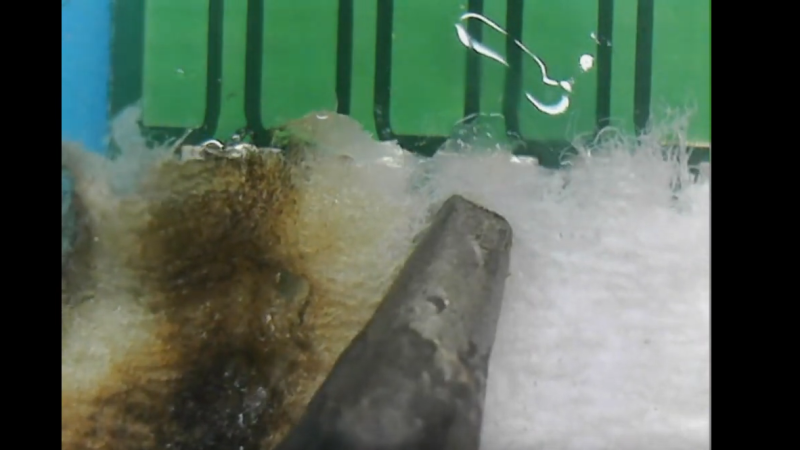It didn’t take long for us to get an answer to the question nobody was asking: Can you use toilet paper as solder wick? And unsurprisingly, the answer is a resounding “No.”
Confused? If so, you probably missed our article a few days ago describing the repair of corroded card edge connectors with a bit of homebrew HASL. Granted, the process wasn’t exactly hot air solder leveling, at least not the way PCB fabs do it to protect exposed copper traces. It was more of an en masse tinning process, for which [Adrian] used a fair amount of desoldering wick to pull excess solder off the pins.
During that restoration, [Adrian] mentioned hearing that common toilet paper could be used as a cheap substitute for desoldering wick. We were skeptical but passed along the tip hoping someone would comment on it. Enter [KDawg], who took up the challenge and gave it a whirl. The video below shows attempts to tin a few pins on a similar card-edge connector and remove the excess with toilet paper. The tests are done using 63:37 lead-tin solder, plus and minus flux, and using Great Value TP in more or less the same manner you’d use desoldering braid. The results are pretty much what you’d expect, with charred toilet paper and no appreciable solder removal. The closest it comes to working is when the TP sucks up the melted flux. Stay tuned for the bonus positive control footage at the end, though; watching that legit Chemtronics braid do its thing is oddly satisfying.
So, unless there’s some trick to it, [KDawg] seems to have busted this myth. If anyone else wants to give it a try, we’ll be happy to cover it.

















LOL, seriously?
You blob on solder till it’s flowing freely, then wipe the excess off the edge of the edge-connector, with TP. Simple.
Yep.
This video is an egregious fail in concept comprehension :) Obviously Adrian story was about someone using toilet paper to _wipe_ hot solder off, not about toilet paper somehow magically absorbing solder.
you know I do state that in the video description, and even when I am using the soldering iron to wipe away the solder it doesn’t do all that much
Um, that’s not what they are saying…
Apologies, my “seriously?” was more directed at HaD than you…
This rollercoaster is just silly… Retinning card-edge-connectors would almost certainly never show up in the HaD feed if it weren’t due to Adrian’s having done it. Adrian’s having done it wouldn’t’ve been viewed on his own channel if it weren’t for Adrian’s having done it. It was silly he even made the vid about it, being how many other things he did with that CGA card; retinning was merely cleaning-montage material. And, as far as HACKS (the H in HaD), another vid of his would’ve been much more appropriate here… wherein he actually started modifying the card’s circuitry. Reading this post, having not even bothered with the last about Adrian’s retinning-vid (having seen the vid prior to the post, here), HaD seems to have put forth a challenge to its readers to debunk a briefly-mentioned/tangential/poorly-described “myth” in Adrian’s vid, hyping up something that was hardly mythical at all… But, frankly, Adrian started that hyped-up-myth by mentioning it in the first place…
A goofy rollercoaster of goofiness on everyone’s part. I should’ve seen it as an adventure for those who enjoy such adventures.
Social-media/vid-fame like this can be a cruel mistress (I know). Sorry I incited a bit of a lynchmob at yah…
How is “absorbing excess solder” (a quote from Adrian’s video) and “wick up excess solder” (a quite from the previous article) *obviously* about wiping?
Melt solder, wack the board on the table. No tp needed
i used to do this till i took a fat glob to the hand doing it, if i do it now i just wear gloves
I did the same like 40 years ago while wearing shorts and got a big blob of solder on one leg just before the knee; traces of the burn remained visible for many years after. Ouch!
Cotton and linen cloth works well and won’t break through leaving hot stuff on your finger. No plastics.
For decades Gulbransen made organs with plug in boards. The edges were originally copper so they thought it was better to tin the fingers, what a mistake! I had to clean with steel wool so many of those, and again. It made me mad. The copper was bad enough with cramolin oil helping retard air but that act led to their entire line falling out of favor. Unreliable as hell.
If the TP or paper towel fibers were impregnated with copper dust or maybe something like root kill (copper sulfate), it might work.. badly.
Here’s my attempt at using toilet paper for cleaning circuit board pads instead of solder wick – ’cause sometimes you don’t have it on hand! https://youtu.be/8i4tnljiuV4
…whether it’s a good idea to do this for a board edge connector is another issue.
“His insistence on removing and throwing away RFI shielding just shows him up to be a selfish fool as well.”
Hm, I see. I suppose it’s generally a thing in the retro hobby to remove shielding for convenient and esthetics.
A friend of our family was both a radio amateur and a long time C64 user.
But despite this, his old C64 had the paper/alu foil shielding partially being removed.
Personally I had kept this installed, also in regards to the radio equipment in the shack.
Because back in the day™, C64 users who were also hams had shielded their C64 keyboard’s cable.
They used the RF shielding braid of RG213 cable or something.
Aw well, the C64 was such a noise generator. 😅
> But despite this, his old C64 had the paper/alu foil shielding partially being removed.
the problem with the ‘paper/alu’ shield is that works as well as ‘heat trap’ for the components inside, I would be happy to keep mine if it was the metal one, but the paper one FFS …
My C64 was pretty much always open and I was always messing about with the guts of it when I was a kid, I remember years ago reading in one of the UK computer/electronics mags about a bit of machine code for the C64 that ‘played tunes’ over a nearby AM radio and it really did, in fact I could hear the tunes on the radio downstairs too.
‘Nearby’ turned out to include the radio ham up the road* he was mildly amused but also quite insistent I put the shielding back in place.
Be nice people, don’t spoil someone else’s hobby in pursuit of your own.
* He was also the Head of Physics at my secondary school, a family friend and my electornics mentor.
English is not my first language but even I understood that is about wiping excess solder not to absorb the solder.
Shielding for non-RF devices (especially for computer hardware) is usually more about dealing with a local jurisdiction’s EMI laws as cheaply as possible rather than protecting people from a very noisy product. My own UK computer from the 80’s is unshielded, but the German version is.
For a hobbyist who is working on a device and isn’t likely to be running it 24/7 near sensitive devices, there’s little to no risk of significant interference. And if nobody nearby is having any problems, what’s the issue?
Adrian Black didn’t use toilet paper as solder wick, it was a throwaway comment in a long (hour?) video where he mentioned a friend would wipe (NOT wick!) molten solder away with it.
I guess that’d work, I mean you could use your fingers and that’d probably work as well. And we’ve all done the “bang it on the table” method of solder removal as well.
When copper cooking utensils are re-tinned, the excess melted tin is wiped away with a heavy cotton cloth.
Also done when sweat-soldering plumbing fittings. A damp rag to wipe away the drips.
and a blowtorch
I know it can be done as a wipe I even elude to it in the video description (though I wouldnt want solder whisps and blobs going everywhere) but as another poster said
How is “absorbing excess solder” (a quote from Adrian’s video) and “wick up excess solder” (a quite from the previous article) *obviously* about wiping?
TP, (or a paper towel), works for a ‘sponge’ to wipe the iron tip. Just fold it over a few times and dampen it.
Thats what I use. Works just fine
I sometimes use a bit of unrolled wetted bog roll tube to wipe the soldering iron tip as I go.
That’s not what I bought it for so I don’t care.
Tell me it’s a slow news day without telling me it’s a slow news day.
Any stranded wire works as DIY solder wick.
Just harvested the LEDs from a string of Christmas lights and don’t know what to do with the wire that has connectors every 8″? Cut it into 4″ chunks and toss it in a bin. Strip off an inch of insulation, give the wires a light twist, dip them into flux, and start Hoovering up excess solder.
Zip cord from old lamps and extension cords works too. In fact, it’s handy to keep different wire gauges for different jobs. 10-gauge will suck up most of a heavy solder joint, and then you can use a piece of 24-gauge to clear the last bit of solder out of the hole.
If you’re short on solder wick, remember that it’s just like copper braid you could find in any cable with a screen, just thicker. If you have old TV or RF cable, that can be a source of decent solder wick; just separate the braid from the rest and pull/twirl it as necessary to make it more consistent, then remember to soak it with flux before use so that it will absorb solder more easily. Just remember to avoid cheap far-east cables as they very likely don’t use copper; old cables people throw away when renovating are often a lot better than newer ones if they didn’t take too much rain, which can be easily checked for after cutting a piece on both ends before stripping them.